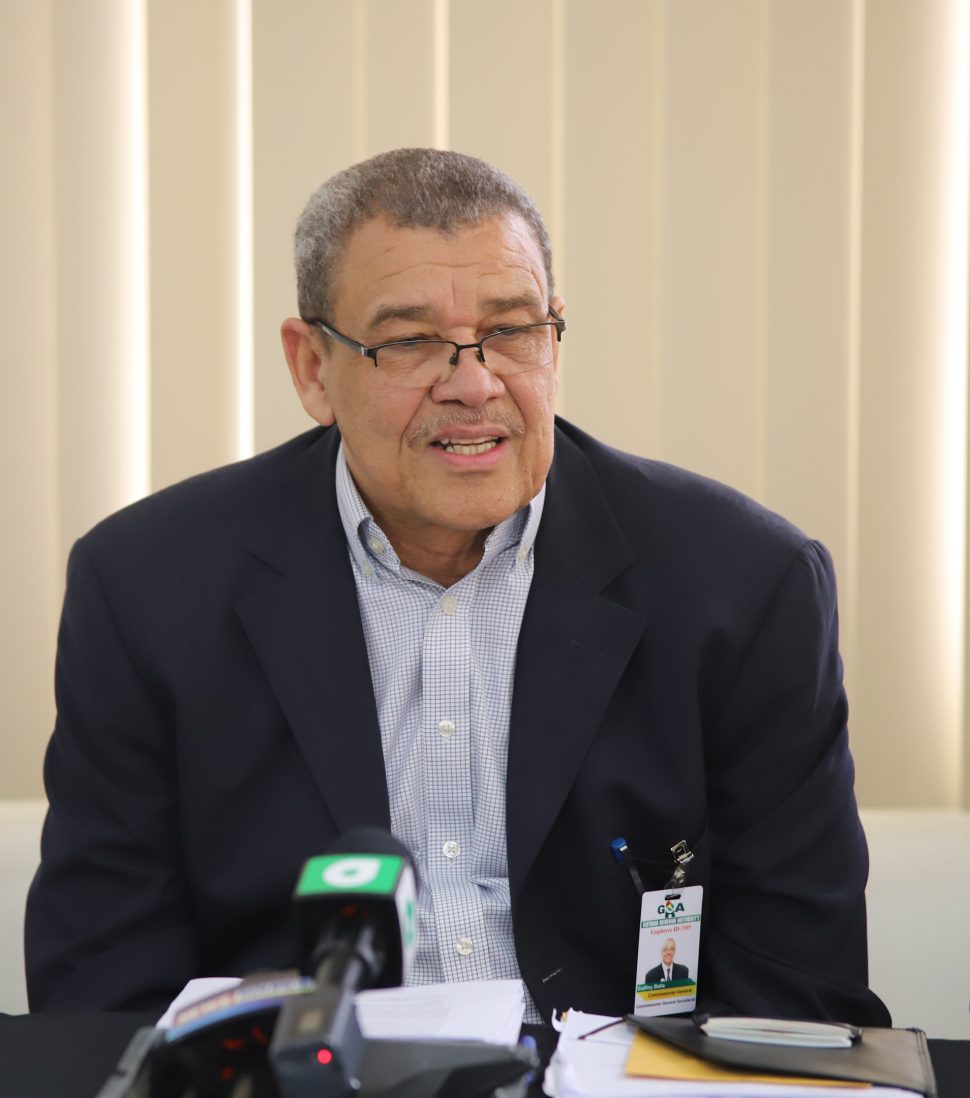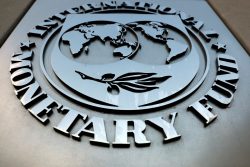In response to articles carried in this newspaper on the findings of the IHS Markit report of ExxonMobil’s spending up to 2017, GRA Commissioner-General Godfrey Statia says that it is not the intent of the government to keep the document secret but that it was still being reviewed by his agency and the Ministry of Natural Resources.
He assured that after the review the document would be made public.
“The GRA and the MNR continue to actively liaise and review the “Final” Audit Report and all Subsidiary Reports for the period 1999 to 2017. Upon completion of its review, its findings shall be made public,” Statia said in a letter in Tuesday’s Stabroek News.
 Three years after he had told this newspaper that the report was completed and handed to the Department of Energy to be forwarded to ExxonMobil for a response, Statia said that the delay was because of an interim audit report, and a series of concerns raised by his agency. He did not detail what the concerns were or if the GRA highlighted additional disputable sums.
Three years after he had told this newspaper that the report was completed and handed to the Department of Energy to be forwarded to ExxonMobil for a response, Statia said that the delay was because of an interim audit report, and a series of concerns raised by his agency. He did not detail what the concerns were or if the GRA highlighted additional disputable sums.
A look at the timeline of the audit revealed that more three years ago, the then APNU+AFC government announced that the United Kingdom-headquartered Information Handling Services (IHS) Markit audit company was procured to undertake the audit. In December of 2019, then Head of the Department of Energy (DoE), Dr Mark Bynoe, announced that the audit would take four months. He had said the contract was for the auditing of pre-contract costs of US$460 million and the company would be paid US$300,000. He later clarified that the period to be audited was up to 2017.
The US$1.6 billion audited figure was never mentioned by either of the two governments and the first time the public learned of the actual sum to be audited was from the IHS market report which was obtained by Stabroek News.
Bynoe at the time had said that personnel from GRA, the Guyana Geology and Mines Commission (GGMC) and DoE would be working alongside the UK team to complete the exercise.
Statia repeated this in his letter on Tuesday and noted that the Auditor General’s Office was also requested to have its team be a part of the audit, but had declined to do so. Attempts to contact Auditor General Deodat Sharma on this matter proved futile as calls to his cell phone number went unanswered.
In May of 2020, Bynoe had informed that the auditing had to be extended, without cost to the auditing firm, due to the COVID-19 restrictions. At that time Guyana was also two months into the 2020 General Elections impasse.
Six months later, and on November 8, 2020, Statia told this newspaper that the report was completed and handed to the DoE to be forwarded to the company for its response. “We have actually completed our part and have given it to the Department of Energy to give to Exxon. When you are finished with an audit, you have to give the other party a chance to respond. That is normal. You have to inform the party of your findings, if not you have not completed the audit so that is where I know we last were,” Statia said.
In the same month, having entered office three months prior, Vice President Bharrat Jagdeo said that the DoE had told him that the review was up to 2017 and the report was, at the time, being looked at. Jagdeo further disclosed that while the US$460 million was the focus, the nation had to be reminded that post-contract costs, totalling over US$20 billion, would have been added to that total and that would form the key area of scrutiny.
Consistent
In February of 2021, when an update was again sought by Stabroek News, Jagdeo disclosed that a mix-up had stalled the audit completion as IHS Markit had submitted its final report without providing a draft and were written to have this corrected.
“They were supposed to have three deliverables – an initial report, a draft, and then the final report. They submitted the draft as the final report on 30 July, I believe,” he had said. “Since then, in the first few months I think we did not pay enough attention to it. Since then, we have had the GRA and the Department of Energy look at the report – there is some committee. The draft, that report, has to be sent to ExxonMobil [who] will have to comment and [as] with any audit, a final report [will] be completed. That will determine whether we accept all of the expenditure that was made in the pre-contract as well as additional expenditure. We would then determine if all of those costs are consistent with the contract’s understanding,” he added. Jagdeo noted that if there is an adverse finding, government will decide how it moves forward. Months would pass with the government repeating the same response that “the audit was being looked at.”
At the end of 2021, former Auditor General, Anand Goolsarran, called on government to release the report saying that they were sitting on it for months without releasing any part of it. The IHS Markit audit, he reasoned, would provide the first real insight into whether ExxonMobil made any undue expense claims.
Lumped
In January of 2022, the Minister of Natural Resources, Vickram Bharrat, informed the Opposition APNU+AFC, who sought answers through Parliament, that it [the audit] was incomplete. Then in February 2022, Bharrat further clarified that the report remained incomplete as queries had to be made. “Our team at the ministry and EEPGL [Esso Exploration and Production Guyana Limited] are working through some details that should be finished soon. There were some queries and we are working though those and then IHS will finish it from there,” he had told this newspaper. “There are queries from us because remember we are looking at their expenses, so we are the ones who have to query it. So we are looking at that to get the details,” he added.
According to Bharrat, some expenses were highlighted by government because they were “lumped” together and additional time was needed to cross-check costs in new and technical oil and gas areas. Bharrat then referred this newspaper to Senior Petroleum Coordinator, Bobby Gossai Jr, within the ministry, for additional information.
Contacted by this newspaper, also in February 2022, Gossai said that the process should be wrapped up within the two to four weeks’ timeframe and proceeded to explain what occurred during the review process.
Government’s Petroleum Coordinator repeated that the process was stalled for verification of areas highlighted and said the teams were finalising the works. The two-week period passed and the same answers were provided – that the report was being finalised.
Government continued to remain tight-lipped on the findings and in August 2022, the former AG, Goolsarran, again urged for the report to be made public.
When the Stabroek News reached out to Vice President Jagdeo, who also has responsibility for the sector, for an update, he again pointed this newspaper to the Minister of Natural Resources. And when contacted, Bharrat gave the assurance that he would provide an update that Friday but never did. President Irfaan Ali had in the very month said that government was building a dedicated website to publish all available information. He would later tell this newspaper in an interview (in September) that he would check on the status of the audit.
In December 2022 Stabroek News reached out to Minister Bharrat and for the sixth time in two years, he repeated that the report would be made available when completed. The only addition to the government’s repetitive line was that ExxonMobil and partners were reviewing the report. “The report is being submitted for review and is in its final stages of approval,” he had said. The Natural Resources Minister did not explain why the review was initiated by ExxonMobil and whose approval has to be sought before it could be handed over to the Government of Guyana.
In January 2023, upon his return from India, President Ali said that he would again check on the report’s status and give an update. In February, the Opposition through AFC Parliamentarian, David Patterson, again sought answers on the audit by way of Parliamentary answers. Minister Bharrat responded, “The review was done by GRA indeed and they would have found that there was need to go back and do some further work with the operator which was done and a final report has now been submitted and is being reviewed by all the relevant stakeholders, including the Petroleum Unit at the GRA. Once that is over we will conclude the first audit very soon.”
Putting to rest
Statia said on Tuesday that he wanted to put “to rest”, any claim that the intention is to keep the report hidden.
He gave the timeline of events from his agency’s perspective.
The agreement with IHSM, he said, stipulated that there be three distinct reports which were delineated as deliverables. These were, the Initial Audit Report, the Intermediate Audit Report and the Final Audit Report.
“Subsequent to a period of preliminary analyses undertaken by the Consultants and Guyanese team, IHSM submitted the Initial Audit Report to the Heads of GRA, DoE and GGMC on March 20, 2020. The Initial Audit Report was reviewed by the GRA team, based on their work assignments and a report was submitted to DoE for transmittal to IHSM,” he said. This was two months before it was announced that the audit would be extended.
On July 31, 2020, Statia said that “IHSM submitted a compiled report which they referred to as the ‘Final Audit Report’, along with the reports for each work stream. The Fiscal Impact Assessment was also submitted by IHSM.”
But procedural requirements that the three-phase reporting be adhered to, where the company should respond to claims highlighted, was bypassed by IHSM. Statia said that the GRA reminded the DoE of this which in turn told ISHM.
However, the Guyana Revenue Authority noted that there was a breach of contractual terms, as well as, Audit Standards and good practices when IHSM attempted to by-pass the Interim Audit Report requirement. Through the DoE, it was related to IHSM that a Final Audit Report cannot be compiled until the Contractor (or Esso Exploration and Production Guyana Limited, in their capacity as the Operator, of the Stabroek Block) is issued with a ‘Written Report’ in conformance with Annex C Section 1.5(B) of the Production Sharing Agreement (PSA)…,” he said.
Statia noted that the PSA also stipulates that “At the conclusion of each audit, the Parties shall endeavour to settle outstanding matters and a written report will be issued to the Contractor within sixty (60) days of the conclusion of such audit.”
“The report shall include all claims arising from such audit. The Contractor shall reply to the report in writing as soon as possible and in any event not later than sixty (60) days following receipt of the report indicating acceptance or rejection of the audit claim and in the case of a rejection showing explanations thereof.”
The GRA pointed out, Statia said, “That it was its firm opinion that a Final Audit Report should only be issued after the Auditee is given an opportunity to officially respond to the initial findings of the draft report. Thereafter their response(s) along with the evidential material submitted should be considered prior to drafting a Final Audit Report. As in the law of equity where “he who asserts must prove”, similarly the auditee has a ‘right to be heard’.”
“Thereafter, two iterations of the ‘Audit Report’ were issued by IHSM between July, 2020 and November, 2020 (June, 2021). It should be noted that in each instance, the Guyana Revenue Authority reviewed the respective reports and conveyed official comments. In depth reports were compiled and submitted to IHSM. In particular, in early 2021, the GRA penned its concerns to IHSM of the following major deficiencies that recurred throughout its report, namely: The Lack of recommendations in the report; Failure to refer to Industry standards and good practices for specific findings; Inaccuracies as it relates to analysing and reviewing the financials; General inconsistencies and deficiencies; Failure to adopt suggestions and recommendations, as well as, address concerns emanating from Government of Guyana Representatives. The GRA further advised that the foregoing, in its opinion had significant adverse effects on the quality of the report and its ability to attain the desired outcomes of arresting unsound financial practices on the part of the contractor and improving Governmental controls.”
He said that GRA further requested IHSM to revise the Draft Audit Report once again, to take account of the issues highlighted in and attached the GoG report which spanned 31 pages. “It also instructed IHSM that in view of the urgency of the long outstanding matter, that the Government expected this request to be addressed with the celerity it warrants and that IHSM would submit the resultant ‘Draft Audit Report’ on or before Wednesday, February 3, 2021 for onward transmittal to the Contractors.”
Effort
IHSM’s Final Report was submitted in March 2021.
Statia said that the Audit Report was presented to EEPGL on July 2, 2021, in its official capacity as Operator of the Stabroek Block to facilitate the Contractor’s response.
It would mean that the 60-day period he referred to would have been triggered and the company would be asked to respond by August 31, 2021.
Statia noted that during the period July 19, 2021 to March 4, 2022, there was ongoing correspondence between EEPGL, the Ministry of Natural Resources and IHSM. He did not say what they were about but that MoNR wanted to conclude the audit and asked GRA to sign off on the document but he could not.
“In an effort to conclude the Audit, in November, 2022, the Ministry of Natural Resources reached out to GRA to obtain its No Objection to the Cost Audit Report. Nonetheless, there were legal, procedural and accounting concerns which deterred the Authority from granting its No Objection”, the Commissioner-General said.
He said that to date “the GRA and the MNR continue to actively liaise and review the “Final” Audit Report and all Subsidiary Reports for the period 1999 to 2017.”









